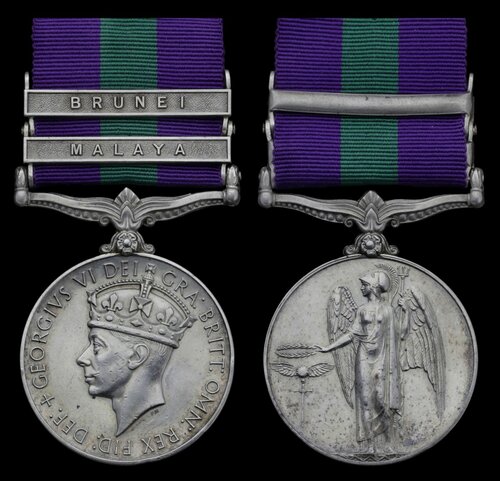
Auction: 21001 - Orders, Decorations and Medals (conducted behind closed doors)
Lot: 282
General Service 1918-62, 2 clasps, Malaya, Brunei (21131073 Spr. Motiram Bura R.E. Gur.), officially re-impressed naming, nearly very fine
As part of a plan to form a Gurkha infantry division for service in Malaya, it was decided to raise an Engineer Regiment of Gurkhas. The first engineer Squadron was formed in Malaya in 1948 and consisted of Royal Engineer officers and non-commissioned officers, a cadre of Gurkha officers and NCOs attached from the Gurkha Infantry Battalions and re-enlisted Gurkha soldiers. A further Squadron was subsequently raised and both Squadrons moved to Hong Kong in 1950 to take over the duties of two British infantry Battalions, which were needed for the Korean War. Here the Squadrons were formed into a Royal Engineers Regiment and served in Hong Kong until 1954, when it was re-deployed to Malaya. The Regiment now undertook engineer tasks in support of the ongoing Malay Emergency, building roads, airfields and helicopter sites to open up areas for the security forces. In 1955, the Regiment was redesignated The Gurkha Engineers, integrated into The Brigade of Gurkhas and adopted its own insignia.
At the time of the outbreak of the Brunei Rebellion on 8 December 1962, 69 Gurkha Independent Field Squadron was engaged in a series of engineer projects for a training area in North Borneo. The Squadron was immediately placed on standby for re-deployment and a detachment of one British officer and 12 Gurkha sappers were flown to Brunei during 8-9 December. On arrival, the detachment was assigned to assist in the defence of the airfield by 1st Battalion, 2nd (King Edward VII's Own) Gurkha Rifles (The Sirmoor Rifles). Later the same day, the detachment moved into Brunei town and took-over the responsibility for guarding rebel prisoners held in the cinema. A second detachment from the Squadron, comprising one British and one Gurkha officer and 30 Gurkha sappers was flown into Brunei on 12th December. Two sections of Sappers were then deployed to support 42 Commando Royal Marines as it cleared rebel strongholds at Limbang and Bangar. During the advance on Bangar, the Gurkha sappers improvised a raft of oil drums to ferry the Commando across a 50m wide river. This was the first occasion in which Gurkha Engineers operated in direct support of combat arms in face of the enemy. The crossing was unopposed and Banger was occupied without further incident. The remainder of 69 Gurkha Independent Field Squadron continued to remain in North Borneo until 6 January 1963 when it was ordered to fly to Brunei. It was to remain on operations in Brunei and the Borneo Territories until July 1963.
Subject to 20% VAT on Buyer’s Premium. For more information please view Terms and Conditions for Buyers.
Sold for
£140
Starting price
£20




